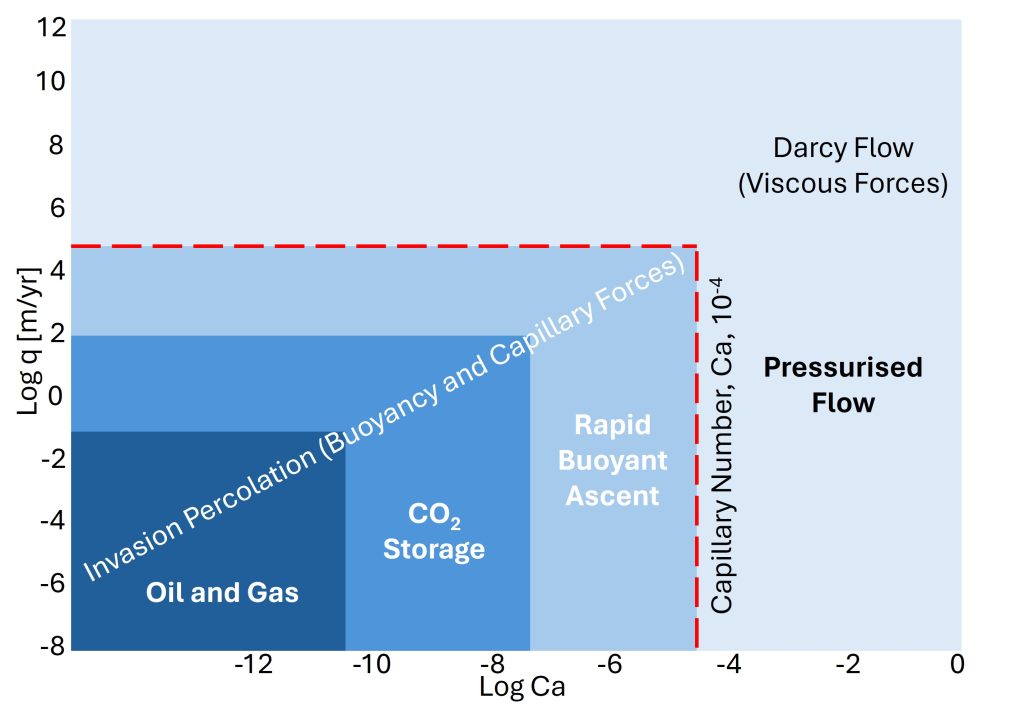Article 4: Grasping Carbon Dioxide Flow physics part 2 – Invasion percolation.
In our previous article, we explored the relationship between capillary, gravity and viscous forces governing CO2 flow in formations, establishing that CO2 storage primarily involves capillary dominated flow due to the low flow rates involved. Building on that foundation, today’s article will introduce a modelling technique, specifically suited for such capillary dominated scenarios, called invasion percolation.
Invasion percolation is a numerical (lattice-based) approach which describes the invasion process of a non-wetting fluid (e.g. CO2) slowly displacing another immiscible fluid (e.g. brine) within a porous media (the rock formation). It captures the dynamics of the displacement process at a microscopic scale, taking into account the interaction between capillary forces influenced by surface tension and pore geometry, and buoyancy forces that are driven by density differences. By considering both forces, advanced invasion percolation techniques allow for more precise modelling of CO2 movement underground.
In invasion percolation, a key factor is the capillary number (Ca), a value indicating the relative strength of capillary forces compared to viscous forces. For invasion percolation to be suitable, a very low Ca (less than 0.0001 or 10-4), should be observed. This aligns appropriately with the CO2 injection and storage scenario. When modelling CO2 storage at such low flux rates, the viscosity contribution to flow becomes negligible and the viscous dominated (Darcy flow) approximation breaks down (Cavanagh and Ringrose, 2011).

An early comparison between Darcy flow and invasion percolation, presented at the 2008 International Geological Congress (Lippard et al., 2008), demonstrated significant disparities in the two models for the Sleipner Storage Benchmark in Norway over a decadal timescale. Using traditional reservoir simulation Darcy flow models, CO2 was predicted to continue moving vertically for many years after injection stopped. However, this did not align with the actual CO2 distribution observed in 4D seismic data, highlighting the limitations of this approach for CO2 storage modelling. When modelled again, this time using a CO2 adapted invasion percolation simulator (Permedia® CO2 Toolkit), the plume distribution was modelled more accurately and provided a close match to the observed seismic distribution (Lippard et. al., 2008, Singh et al., 2010)
Subsequent detailed studies compared traditional black oil reservoir simulations with CO2 storage migration simulations using a shared geological model for the upper portion of the Sleipner storage site (Sleipner Storage Benchmark). It was revealed that invasion percolation modelling was favoured over reservoir simulation as a preliminary approximation. This preference arises from invasion percolation’s focus on the interplay between capillary and buoyancy forces, disregarding pressure-driven flow, making it computationally efficient compared to full-physics simulators, while still honouring the governing physics of migration.
Ongoing research and comparison studies highlight the differences in the movement and migration of CO2 and hydrocarbons in the subsurface. By leveraging capillary-dominated flow through invasion percolation, researchers and industry workforces alike can create more dependable models for CO2 storage. This approach provides valuable insights into both the short-term risks and the long-term understanding of CO2 stored underground. Furthermore, employing modified invasion percolation techniques in modelling CO2 storage scenarios aids in defining the storage complex and area of review, fulfilling legislative requirements for any CCS project.
In conclusion, invasion percolation offers a powerful and computationally efficient approach for modelling CO2 storage, particularly under capillary-dominated flow conditions. By incorporating both buoyancy and capillary forces, this method provides more accurate predictions of CO2 movement and distribution compared to traditional models. Furthermore, invasion percolation is a valuable tool not only for researchers studying CO2 storage, but it also offers practical benefits for the CCS industry. By incorporating modified invasion percolation techniques into storage scenario modelling, companies can define the storage complex and area of review, fulfilling legislative requirements and ensuring their CCS projects meet safety and environmental standards. However, continued research and comparisons between invasion percolation and other modelling techniques are essential for further refining our understanding of CO2 migration in geological formations.
Benjamin Adillah, Senior Reservoir Engineer
References
- Bebb, F, 2021, Understanding Flow Dynamics of CO2 Plumes in the Subsurface. Subsurface Insights, February 2021, p. 21–25.
- Bebb, Florence Letitia, Evans, Kate Clare Serena, Mukherjee, Jagannath, Saeed, Bilal, and Geovani Christopher. “Understanding the Flow Dynamics of CO2 Plumes in the Subsurface.” Paper presented at the Abu Dhabi International Petroleum Exhibition & Conference, Abu Dhabi, UAE, November 2021. Doi: https://doi.org/10.2118/207539-MS.
- Cavanagh, A. and P. Ringrose 2011. Simulation of CO2 distribution at the In Salah storage site using high-resolution field-scale models. Energy Procedia, v. 4, p. 3730–3737.
- Lippard, J, A. Cavanagh, D. Kennedy and C. Hermanrud 2008. Modelling of CO2 injection and seismic data analysis in the Utsira formation. GFOSS Session at the 33rd IGC Geoscience World Congress 2008. International Geological Congress (IGC). Poster.
- Singh, V.P., A. Cavanagh, H. Hansen, B. Nazarian, M. Iding and P.S. Ringrose 2010. Reservoir Modeling of CO2 Plume Behavior Calibrated Against Monitoring Data From Sleipner, Norway. SPE Annual Technical Conference and Exhibition. Society of Petroleum Engineers SPE-134891. p 1–18.



